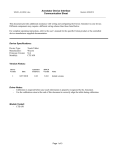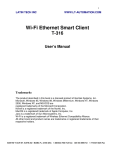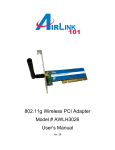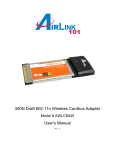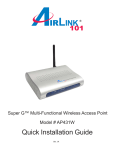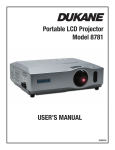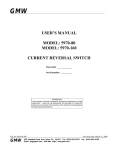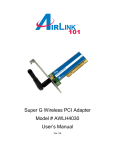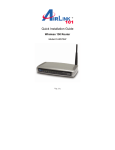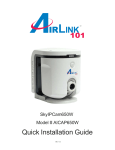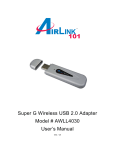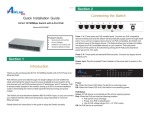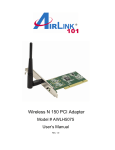Download 802.11g Universal Wireless Repeater Model # AP311W User`s Manual
Transcript
802.11g Universal Wireless Repeater Model # AP311W User’s Manual Ver. 1C Table of Contents 1. Introduction................................................................................................................................. 3 2. Using the Setup Wizard .............................................................................................................. 4 3. Connecting to the Wireless Repeater........................................................................................ 11 4. Web Configuration Utility ........................................................................................................ 13 4.1 Basic Setup.......................................................................................................................... 13 4.1.2 Configuring Wireless Security......................................................................................... 15 WEP ...................................................................................................................................... 16 WPA Pre-shared Key............................................................................................................ 17 4.2 Password ............................................................................................................................. 18 4.3 Firmware ............................................................................................................................. 19 Technical Support ......................................................................................................................... 20 2 1. Introduction Congratulations on your purchase of this 802.11g Universal Wireless Repeater. The Wireless Repeater extends the range of your access point/wireless router by repeating the signal to wireless clients that are beyond the broadcasting range of the access point/wireless router. This provides the wireless clients with greater flexibility and mobility. Best of all the Wireless Repeater is compatible with existing 802.11b and 802.11g network devices so it will work with most existing wireless devices. This product is specifically designed for Small Office and Home Office needs. It provides a complete SOHO solution for Internet surfing and is easy to configure and operate even for non-technical users. Instructions for installing and configuring this product can be found in this manual. Before you install and use this product, please read this manual carefully for proper operation of this product. Package Contents Before you begin the installation, please check the items of your package: • • • • 802.11g Universal Wireless Repeater Power Adapter Quick Installation Guide Manual CD If any item contained is damaged or missing, please contact your local dealer immediately. Also, keep the box and packaging materials in case you need to ship the unit in the future. 3 2. Using the Setup Wizard Step 1 Verify the Repeater is powered on, insert the provided CD, and wait for the autorun screen to appear. Step 2 Click on Setup. Note: If the autorun screen does not appear automatically, go to Start, Run, type D:\setup.exe (where D is the letter of your CD drive) and click OK. Step 3 Click Next and wait for the wizard to detect your access point / wireless router (this may take up to a minute). 4 Step 4 Select the SSID (Network Name) of your access point / wireless router from the Selection list. Click Yes if you see your SSID in the list and you don’t have encryption enabled for your wireless network. Skip to Step 8. Click Yes if you see your SSID and you have encryption enabled. Skip to Step 6. Click Manual if you don’t see your SSID in the list. Continue to Step 5. Step 5 Enter the SSID (Network Name) of your access point / wireless router in the SSID field and select the appropriate Channel and Encryption settings and click Next. Note: You may gather these information from the web configuration utility of your wireless router. 5 WEP Step 6a Select the same level of WEP encryption (64-Bits / 128-Bits) of your wireless network from the drop-down menu. Step 6b Enter the same WEP key (password) of your wireless network in the Key 1 field and click Next. Skip to Step 8. 6 WPA-PSK Step 7a Enter the same Pre-Shared Key (passphrase) of your wireless network in the Pre-Shared Key field and click Next. Step 8 Select the Repeater from the list, verify the Repeater Name is AP311W, and click Yes. 7 Step 9 The default password for entering the Repeater’s Web Configuration Utility is admin. To change the password, enter the new password in the Password field and click Enter. Step 10 If you know your Network IP Address settings, enter them in the applicable fields. If you are not sure, just click Next. 8 Step 11 Review your new settings and click Yes continue. Step 12 Click Exit to exit the Setup Wizard. 9 Step 13 For best result, place the Repeater at a central location between the wireless router and your wireless computers. 10 3. Connecting to the Wireless Repeater Once you have properly configured the Repeater, your wireless computers should be able to detect its signal. Use your wireless network adapter’s utility to detect and connect to the Repeater. You can identify the Repeater by its MAC Address, which is displayed in the BSSID field of your wireless network adapter’s utility. You can check the Repeater’s MAC Address on its Web Configuration screen. Step 1 Open your Web Browser (Internet Explorer or Netscape), enter the default IP Address of the Repeater 192.168.1.250 in the Address Bar and press Enter. Note: If you have changed the IP Address of the Repeater, enter the Repeater’s new IP Address instead of the default. Step 2 Enter admin for both the User name and Password fields and click OK. 11 Step 3 The Repeater’s MAC Address is displayed on the Basic Setup page. If the signal is weak, try reorienting the Repeater’s antenna or relocate the Repeater to a different place. 12 4. Web Configuration Utility The Wireless Repeater comes with a built-in Web Configuration Utility that allows you to easily setup the Repeater with your web browser. This section describes how to use the Web Configuration Utility. 4.1 Basic Setup Step 1 Open your Web Browser (Internet Explorer or Netscape), enter the default IP Address of the Repeater 192.168.1.250 in the Address Bar and press Enter. Note: If you have changed the IP Address of the Repeater, enter the Repeater’s new IP Address instead of the default. Step 2 Enter admin for both the User name and Password fields and click OK. 13 The Basic Setup tab is the main screen for configuring the Wireless Repeater. Firmware Version: Displays the current firmware version number. Name: Displays the name of the Wireless Repeater. IP Address: Assign an appropriate IP Address for the Repeater. Subnet Mask: Assign an appropriate Subnet Mask for the Repeater. Gateway: Assign an appropriate Default Gateway for the Repeater. Mode: Choose to have the Repeater broadcast in B-Only, G-Only, or Mixed mode. SSID Broadcast: Choose to Enable or Disable the broadcast of SSID. Channel: Select the desired channel number. Wireless Security: Select to Enable or Disable wireless security encryption. To edit the encryption setting, click on the Edit Security Settings button. After you have completed the changes, click on Save Settings to apply the changes. 14 4.1.2 Configuring Wireless Security To enable Wireless Security, select Enable and click on Edit Security Settings. This Repeater supports both WEP and WPA Pre-shared Key encryption. It is recommended that use WPA Pre-shared Key encryption if your wireless network supports it. 15 WEP The default security screen is the WEP screen. Here you can setup the WEP settings for your wireless network. Note that these settings must be exactly the same as your access point/wireless router. Security Mode: Choose between WEP and WPA Pre-shared Key. Default Transmit Key: Select a key to be the active key. WEP Encryption: Choose between 64-bit and 128-bit encryption. Passphrase: You can enter a passphrase and click on the Generate button and the Repeater will automatically generate four WEP keys for you. Key 1 – 4: Manually assign a passphrase for each key. If you selected 64 bits encryption, enter 10 HEX characters (0-F) for each key. If you selected 128 bits encryption, enter 26 HEX characters (0-F) for each key. For each key select either Open System or Shared Key as your authentication. Click on Save Settings to apply the changes. 16 WPA Pre-shared Key To use WPA Pre-shared key, choose WPA Pre-shared key from the Security Mode drop-down menu. WPA Shared Key: Enter a passphrase for your wireless network. Group Key Renewal: Enter the desired key renewal time in seconds. Note that these settings must be exactly the same as your access point/wireless router. Click on Save Settings to apply the changes. 17 4.2 Password The Password tab allows you to change the Repeater’s login password as well as other administrative functions. Password: Enter the new login password and re-enter to confirm the new password. Click Save Settings to apply the changes. Restore Factory Defaults: Select Yes and click on Save Settings to reset all of the Repeater’s settings to factory default. Backup/Restore Setting: You can backup the Repeater’s settings as a file in your computer by clicking on the Backup button. Later, when you want to restore your saved settings, just click on the Restore button and browse to the location of the saved file. 18 4.3 Firmware The Firmware tab allows you to upgrade the Repeater’s firmware. You can download the updated firmware from our web site at www.airlink101.com Step 1 Unzip the new firmware and then click on the Firmware Upgrade button. Step 2 Click on Browse to locate the new firmware and click on Upgrade to update the firmware. 19 Federal Communication Commission Interference Statement This equipment has been tested and found to comply with the limits for a Class B digital device, pursuant to Part 15 of the FCC Rules. These limits are designed to provide reasonable protection against harmful interference in a residential installation. This equipment generates, uses and can radiate radio frequency energy and, if not installed and used in accordance with the instructions, may cause harmful interference to radio communications. However, there is no guarantee that interference will not occur in a particular installation. If this equipment does cause harmful interference to radio or television reception, which can be determined by turning the equipment off and on, the user is encouraged to try to correct the interference by one of the following measures: - Reorient or relocate the receiving antenna. Increase the separation between the equipment and receiver. Connect the equipment into an outlet on a circuit different from that to which the receiver is connected. Consult the dealer or an experienced radio/TV technician for help. This device complies with Part 15 of the FCC Rules. Operation is subject to the following two conditions: (1) This device may not cause harmful interference, and (2) this device must accept any interference received, including interference that may cause undesired operation. FCC Caution: Any changes or modifications not expressly approved by the party responsible for compliance could void the user's authority to operate this equipment. IMPORTANT NOTE: FCC Radiation Exposure Statement: This equipment complies with FCC radiation exposure limits set forth for an uncontrolled environment. This equipment should be installed and operated with minimum distance 20cm between the radiator & your body. This transmitter must not be co-located or operating in conjunction with any other antenna or transmitter. Gemtek declares that WACM-123G ( FCC ID: MXF-A940727G ) is limited in CH1~CH11 for 2.4GHz by specified firmware controlled in U.S.A. Technical Support E-mail: [email protected] Toll Free: 1-888-746-3238 Web Site: www.airlink101.com *Theoretical maximum wireless signal rate based on IEEE standard 802.11g specifications. Actual data throughput will vary. Network conditions and environmental factors, including volume of network traffic, building materials and construction, mix of wireless products used, radio frequency interference (e.g., cordless telephones and microwaves) as well as network overhead lower actual data throughput rate. Copyright © 2005 AirLink101. All rights reserved. AirLink101, the stylized AirLink101 logo, specific product designations, and all other words and logos that are identified as trademarks and/or service marks are, unless noted otherwise, the trademarks and service marks of AirLink101. All other product or service names are the property of their respective holders. AirLink101 products are protected under numerous U.S. and foreign patents and pending applications, mask work rights, and copyrights. 20





















